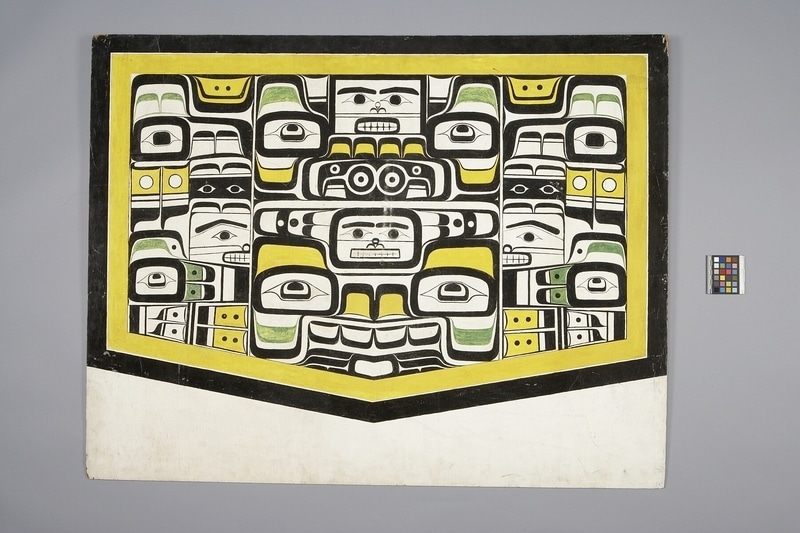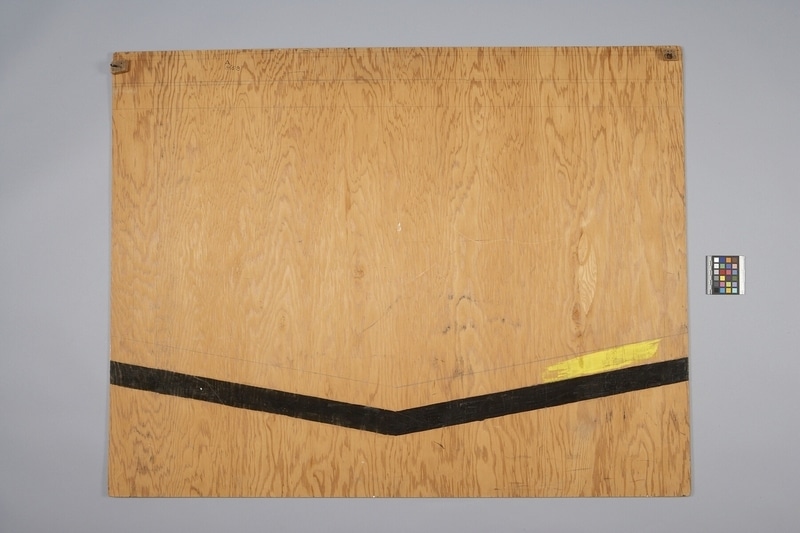Chilkat Pattern Board Item Number: A3658 from the MOA: University of British Columbia


Description
Rectangular board with expansive and geometric designs in white, black, green and yellow on one side.
History Of Use
The design for a chilkat style robe was traditionally painted onto a pattern board by a man, then precisely copied in weaving by a woman. The style operated within strict conventions, but at the same time permitting subtle individual variations and originality. Full-sized renderings of the designs were painted on the boards, which are made of cedar planks finely adzed to a smooth surface. Because the blanket designs are symmetrical, normally only one half is painted (see A8326 or 3379/1), but this board has the complete design. Pattern boards were highly valued, and would normally have been used more than once by the same weaver.
Narrative
This board was made by Mungo Martin for his wife to weave a dance apron while they were working at the UBC Museum of Anthropology in 1951. This pattern board appears to be unusual because it is a complete rendering of both sides of the design, and includes the borders and colours. According to Cheryl Samuel, boards usually represent only half the blanket, were painted only in black, and did not include the borders.
Cultural Context
textiles; weaving
Iconographic Meaning
Emblems or crests may distinguish different social groups. (lineages, phratries, or moieties) and symbolize their privileges. They can be shown on any material possessions, such as totem poles or robes, and each group owns the right to display specific crests. Within each group, families or individuals have the right to show the general crests is specific ways.
Item History
- Made by Mungo Martin (Maker) in Vancouver, British Columbia, Canada during 1951
- Collected during 1951
- Owned by Mungo Martin before 1951
- Received from H. R. MacMillan (Funding source) and Mungo Martin (Seller) during 1951
What
- Name
- Chilkat Pattern Board
- Identification Number
- A3658
- Type of Item
- pattern board
- Material
- paint and wood
- Manufacturing Technique
- drawn and painted
- Overall
- height 95.0 cm, width 123.0 cm
Who
- Culture
- Kwakwaka'wakw
- Creator
- Mungo Martin (Maker)
- Previous Owner
- Mungo Martin
- Received from
- H. R. MacMillan (Funding source) and Mungo Martin (Seller)
Where
- Holding Institution
- MOA: University of British Columbia
- Made in
- Vancouver, British Columbia, Canada
When
- Creation Date
- during 1951
- Collection Date
- during 1951
- Ownership Date
- before 1951
- Acquisition Date
- during 1951
Other
- Condition
- fair
- Accession Number
- 2070/0001